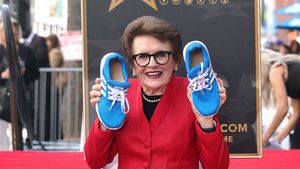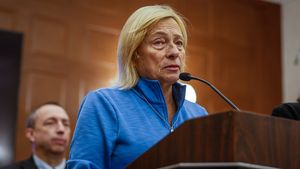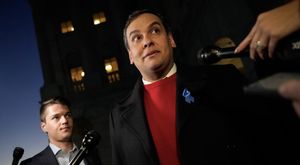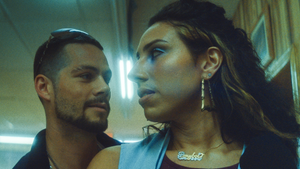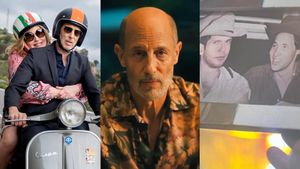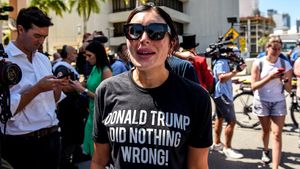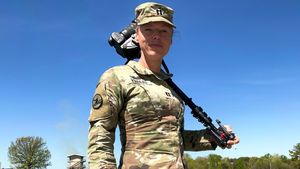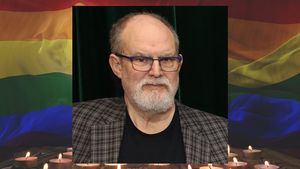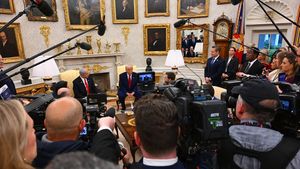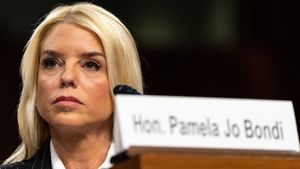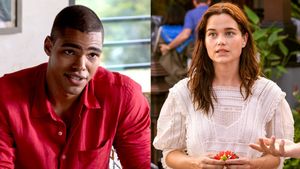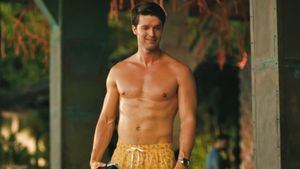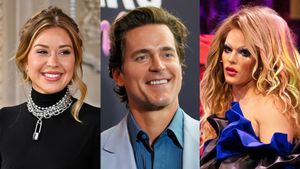
Treatment GuideJust DiagnosedSex & DatingAfrican AmericanStigmaAsk the HIV DocPrEP En EspañolNewsVoicesPrint IssueVideoOut 100
CONTACTCAREER OPPORTUNITIESADVERTISE WITH USPRIVACY POLICYPRIVACY PREFERENCESTERMS OF USELEGAL NOTICE
© 2025 Pride Publishing Inc.
All Rights reserved
All Rights reserved
Scroll To Top
By continuing to use our site, you agree to our Private Policy and Terms of Use.
At the seasoned age of 23, Murray helped create the young-adult HIV-awareness organization Hope's Voice in 2004'only three years after learning that he had contracted the virus. 'I was part of the first generation to ever live my entire life in a world with HIV,' he says, 'and yet my first education about it came when I found out I was living with the disease. Several months after, I learned that half of all new HIV infections are in people under 25. Why did I feel so alone? Why didn't I take the opportunity to educate myself before my diagnosis? How had I gone through an entire life and not have had any personal connection to the epidemic? Was I going to spend my entire life feeling shame and guilt or to stop living my dreams? Why was the only emotion I related to HIV fear?' With so many questions'and a background in social marketing to give him the tools to start discovering the answers for himself and for others'Murray says he had an awakening: 'Sexual education was disappearing, and we were at a crossroads. I knew that I had two choices: I could live with the way things were or commit my life to making a change. The organization was a direct response to the crisis of the lack of accurate and comprehensive sexual education for young people.' Now Murray talks with HIV Plus about his experiences in his personal fight against HIV, the successes Hope's Voice has achieved in the broader AIDS battle, and what's next for him as one of the next-generation HIV/AIDS leaders. For starters, how old were you when you found out you were HIV-positive, and how old are you now? I found out I was HIV-positive when I was 20, and I am now 27. At what point did you feel that there was something missing from the info about HIV that was available for America's youth? Basically, what was the awakening moment for you? I was the first generation to ever live my entire life in a world with HIV, and yet my first education on the virus came when I found out I was living with the disease. Several months after finding out I was positive I learned the statistic that half of new HIV infections are in young people under 25. Why did I feel so alone? Why didn't I take the opportunity to educate myself before my diagnoses? How had I gone through an entire life and didn't have any personal connection to the epidemic? Why was I going to spend my entire life feeling ashamed or guilty--or to stop living my dreams? Why was fear the only emotion I related to HIV? It was clear that I didn't have access to accurate sexual education. It was when I stopped living in fear and shame and started asking these questions that I realized that there were many things missing for American youth. I wasn't the only one asking these questions. I knew that I had two choices: I could live with the way things were or commit my life to making a change. For me, that was my awakening moment. I knew that sexual education was disappearing and that we were at a crossroads. The organization was a direct response to the crisis of the lack of accurate and comprehensive sexual education to young people. My peers were taught to fear HIV and did not have a personal connection to the epidemic, and it was time to change that. Hope's Voice International came about after meeting and being inspired by countless young people with HIV. It opened my eyes to the diversity of the disease, and I wanted the world to hear these stories. I wanted to commit my life to social marketing and embrace our realities. I founded Hope's Voice International to be a platform for these and future speakers to do what they do best: educate and inspire their peers. Hope's Voice International was founded to provide an education and personal connection to young people without using fear. How daunting was the idea of forming the organization, especially for someone so young? The idea was a bit overwhelming, but the idea of simply accepting the way things were drove me to put in the time, effort, and money to get started. I knew that my desire to make change would be the motivating factor in dealing with the challenges. I had experience and a passion for social marketing and understood that I needed to do my research in order to secure funding. I worked on the organization for over a year before starting to promote the organization and its work. It was important that I clearly understood what the objectives of the organization were going to be. I found that support was difficult at first. Many people were not inclined to hear the thoughts of a 20-something and were confident that their ways worked. The organization required a great deal of time and financial and emotional sacrifice. I quickly learned that for every nine doors closed, one will open. I never found age to be a barrier for me. In fact, it's what I knew was going to be my best asset. I was young, passionate, and knew exactly what I wanted. I found the inability for people to accept new concepts or the way to do things to be my biggest challenge when forming the organization. The support for young people and their ideas is lacking in this community. We seem to have accepted that half of new HIV infections in people under the age of 25 is acceptable. There are many days I wonder why it had to be such a struggle to get to here. In order to address HIV infection among young people we must put our support, dollars, and energy into supporting those who can deal with the issue the best--young people. It is the young people of today that can address the epidemic among their peers and will be the leaders of tomorrow. How did you first start making contact with others? Was it on the Web? Was it tough getting people on board with you, or were they eager? Early in my advocacy career I attended conferences, used the Internet, and utilized support groups to connect with other young positive individuals. In that time I had the opportunity to meet so many incredible and talented young HIV-positive individuals. It was clear that there were passionate and driven young positive individuals who were incredible speakers. It was also clear that we were--and still are--facing a crisis in sexual education. I wanted the organization to provide the stability for a young speaker to have a lasting and positive experience as an advocate. I knew that when I started Hope's Voice it wouldn't be for everyone. Disclosing your status online and to complete strangers can be overwhelming. After working on the structure, I reached back out to those I had met and explained my vision. The agency started with four speakers and quickly the new of our work spread by word of mouth. Why did you move the organization to New York City from your home in San Francisco? There were several reasons. We had every intention of Hope's Voice expanding around the world, and in order to do so we needed to be based in New York City. The United Nations, funders, and partners were based here, and being able to have face-to-face meetings was important for securing solid relationships. We also found that New York had a larger media market and seemed to be optimistic and excited about new projects and ideas. The first few years of the organization I spent a lot of time trying to convince people that Hope's Voice offered unique and effective solutions. Unfortunately, [in San Francisco] I found my words fell on deaf ears and knew that I needed a city that learned from the past but will also try new things in the future. How big a part of Hope's Voice has the 'Does HIV Look Like Me?' campaign been? That campaign has always been major part of the organization. It was the name of the programs that speakers did in schools in the United States and was on all the promotional materials. This last November we expanded it to an international campaign and added several components, including the print campaign, leadership training, and the social networking website. The campaign is personal for me. Shortly after finding out I was HIV-positive, I looked into the mirror and asked myself, 'Does HIV look like me?' The day when I accepted myself was the day that I embraced that question with a yes. As have the speakers and ambassadors around the world. How many different years did you guys take RV trips across the country to colleges and universities to speak? And how many speakers have been a part of the campaign over the years? We've done two Road to Hope tours. The month-long RV trips travel to over 20 schools presenting the messages from the Hope's Voice speakers. The work behind putting together this project is extensive, so with the international expansion this year we took a year off from the tour. Through those tours, we represented more than 25 speakers--and with international expansion--we currently have more than 120 ambassadors in Mexico, South Africa, Swaziland, the United Kingdom, and in this country. How did you know it was time to go international and turn the organization into Hope's Voice International? We'd become the leader in HIV education and campaigning here in the United States, and I was confident that our approach, campaign, and message would be universal and be successful in any country. Then we began receiving speaker applications from young people from around the world. With their limited finances, it was clear that we needed to find a platform to allow every advocate to share her or his story. We believe in using the latest technologies and trends, and that's exactly what we did. In 2007 we expanded 'Does HIV Look Like Me?' to be a user-generated content campaign. We asked young people to send in a video of life with HIV or AIDS. The idea was a hit, and we started to receive tapes from around the world! At that point it was clear that Hope's Voice International had the capacity and skills to take the work to the next level. There was harsh criticism that our approaches worked only because we were in the United States, but I was confident and eager to show the international community that it could work in any country that fit the criteria. It was important to me that we did more than just go into a country, film their tapes, and leave. The comprehensive campaigns not only provide the multimedia tools for the in-country partners but also the space for young leaders to talk openly about their needs. The young leaders and partners have shown the world that Hope's Voice International was not only capable but was the right fit to do the job. Why did you choose the specific countries you did, and are there more planned for the near future? We worked closely with the selected country campaign host and our international partners when we selected the countries. We used the following criteria when selecting the countries and campaign hosts are the following: >Commitment of the country campaign hosts to assist in logistics of the campaign and training. >Structure of country campaign hosts to support and sustain the ambassadors and campaign. >History of involvement of young [HIVers] in prevention campaigns. >History and current climate of the safety of the ambassadors in the country. >Access to [HIVers] who will participate in the campaign and training. >Access and support from additional partners and financial campaign supporters. >Government support for [HIVer] initiatives. >Media support for [HIVer] initiatives. >Access and support to distribute materials to reach young people in the country. Mexico, South Africa, and Swaziland had strong in-country support and met the criteria. We've received interest from organizations, corporations and governments around the world interested in bringing 'Does HIV Look Like Me?' to their country, and we're in talks to produce more campaigns that meet the criteria and have the support needed. What kind of feedback are you getting from the public? How are they letting you know that your efforts are appreciated and that you're on the right track with your programs and campaigns? The feedback from the public has been incredible! The public has voiced its support for our work, messages, and materials with e-mails from around the world. When we traveled to Mexico, South Africa, and Swaziland to produce 'Does HIV Look Like Me?' the response from the ambassadors, partners, and community and government officials was completely supportive. In each country the ambassadors embrace the work and see us as their sisters and brothers. They were excited to partner to build a campaign that embraced and share their messages with their country and the world. In Mexico the campaign will be the first there to feature young people living with HIV or AIDS, and in South Africa and Swaziland we had more ambassadors than we had beds. The school programs in the United States continue to increase each year, and we are thrilled that after each program, students write to the speakers and share their thanks and their own experiences of getting an HIV test after attending a program. Our website provides an opportunity for visitors to write directly to ambassadors, and they are receiving e-mails from around the world from visitors who watched their videotaped messages and saw them in our print campaign. The e-mails share their appreciation to these incredible individuals and the overwhelming confirmation that they are not alone. This work can often be exhausting, but it has been the e-mails of support that come to Hope's Voice International that gives us the energy to keep going. What's next from Todd Murray and Hope's Voice? And what's the lasting impact that you want to have? Hope's Voice International has lot of work ahead. We have completed postproduction on the 'Does HIV Look Like Me?' campaigns in Mexico, South Africa,and Swaziland and will be releasing the country campaigns in the fall. We will be working with ambassadors and local and international partners on the distribution, events, media placement, and development of the campaign in each country. We are talking with partners around the world who are interested in bringing the campaign to their country. We look forward to announcing the next round of countries in December for next year. The 'Does HIV Look Like Me?' campaign just launched a new, interactive online membership platform that is available for any young people living with HIV to join (anonymously, if they choose) offering extensive online social networking features such as blogs, instant messaging, a global directory of members' profiles, and an e-group to connect and sustain the movement. People can join the interactive online community by visiting www.doeshivlooklikeme.org. We are gearing up for the 2008-2009 school year. The speakers will start traveling the United States presenting the 'Does HIV Look Like Me?' program this fall to thousands of high school, college, and university students. Hope's Voice International has released and is starting to promote our 'AIDS Does Discriminate' corporate diversity training. This program for businesses features the speakers of Hope's Voice International and the media materials from 'Does HIV Look Like Me?' We will be bringing an education on HIV and AIDS to businesses both here in the United States and around the globe. What is next for Todd Murray? I hope a really long nap! The last year has been exhausting. I am so proud of how far we have come and Hope's Voice International has exceeded my wildest dreams. In many ways I have to continue to prove myself and Hope's Voice International. My hope is that in the future we can put that to rest. Is there anything else you'd like to add? We need support. I know that many AIDS organizations are struggling to keep their doors open. Hope's Voice International continues to struggle too to meet the demand. I would like to encourage the readers of HIV Plus to recognize that in order to make a difference in the next 10 years we must stay committed--both emotionally and financially--to this work. We often become complacent in this epidemic, and if there is anytime that we cannot it is now. The numbers of new young people that are being infected are staggering. We must commit our resources and efforts to reaching those who are at risk and those who have already become infected. Assuming that this is the way it will be is not a mindset that we should ever have.
From our Sponsors
Most Popular
Lexi Love comes out as HIV+ after Trump deletes federal resources
January 23 2025 11:23 AM
Ricky Martin delivers showstopping performance for 2024 World AIDS Day
December 05 2024 12:08 PM
Trump's orders prompt CDC to erase HIV resources
January 31 2025 5:29 PM
Meet our Health Hero of the Year, Armonté Butler
October 21 2024 12:53 PM
California confirms first case of even more deadly mpox strain
November 18 2024 3:02 PM
This long-term HIV survivor says testosterone therapy helped save his life.
December 16 2024 8:00 PM
Plus: Featured Video
Latest Stories
Broadway's best raise over $1 million for LGBTQ+ and HIV causes
April 03 2025 7:15 PM
Jess King is here to help you live your happiest, healthiest life yet
March 24 2025 4:35 PM
Celebrating Black History Month with our annual African American issue
February 01 2025 3:28 PM
Plus nominated for 2025 GLAAD Media Award
January 22 2025 12:42 PM
Hollywood must do better on HIV representation
December 01 2024 9:00 AM
Check out our 2024 year-end issue!
October 28 2024 2:08 PM
Twice-yearly injectable lenacapavir, an HIV-prevention drug, reduces risk by 96%
October 15 2024 5:03 PM
The Talk Season 5 premieres this spring with HIV guidance for the newly diagnosed
March 26 2025 1:00 PM
Discover the power of Wellness in your life
March 26 2025 12:41 PM
BREAKING NEWS: Trump admin moves to end federal HIV prevention programs
March 18 2025 6:10 PM
Tyler TerMeer vows to continue to fight for health care for all
January 28 2025 3:00 PM
A camp for HIV-positive kids is for sale. Here's why its founder is celebrating
January 02 2025 12:21 PM
AIDS Memorial Quilt displayed at White House for the first time
December 02 2024 1:21 PM
Climate change is disrupting access to HIV treatment
November 25 2024 11:05 AM
Season 4 of The Switch on resilience & radical self-love returns this spring
March 26 2025 12:20 PM
Gerald Garth is keeping people of color happy and healthy through trying times
March 11 2025 3:38 PM
'RuPaul's Drag Race' star Trinity K Bonet quietly comes out trans
December 15 2024 6:27 PM
Decades of progress, uniting to fight HIV/AIDS
December 01 2024 12:30 PM
Post-election blues? Some advice from mental health experts
November 08 2024 12:36 PM
AIDS/LifeCycle is ending after more than 30 years
October 17 2024 12:40 PM




























